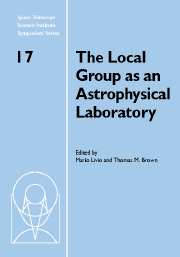 The Local Group as an Astrophysical Laboratory
The Local Group as an Astrophysical Laboratory Book contents
- Frontmatter
- Contents
- Participants
- Preface
- History of the Local Group
- Primordial nucleosynthesis
- Galactic structure
- The Large Magellanic Cloud: Structure and kinematics
- The Local Group as an astrophysical laboratory for massive star feedback
- Hot gas in the Local Group and low-redshift intergalactic medium
- Stages of satellite accretion
- The star formation history in the Andromeda halo
- Bulge populations in the Local Group
- The Local Group as a laboratory for the chemical evolution of galaxies
- Massive stars in the Local Group: Star formation and stellar evolution
- Massive Young Clusters in the Local Group
- Magellanic Cloud planetary nebulae as probes of stellar evolution and populations
- The old globular clusters: Or, life among the ruins
- Chemical evolution models of Local Group galaxies
Chemical evolution models of Local Group galaxies
Published online by Cambridge University Press: 12 May 2010
- Frontmatter
- Contents
- Participants
- Preface
- History of the Local Group
- Primordial nucleosynthesis
- Galactic structure
- The Large Magellanic Cloud: Structure and kinematics
- The Local Group as an astrophysical laboratory for massive star feedback
- Hot gas in the Local Group and low-redshift intergalactic medium
- Stages of satellite accretion
- The star formation history in the Andromeda halo
- Bulge populations in the Local Group
- The Local Group as a laboratory for the chemical evolution of galaxies
- Massive stars in the Local Group: Star formation and stellar evolution
- Massive Young Clusters in the Local Group
- Magellanic Cloud planetary nebulae as probes of stellar evolution and populations
- The old globular clusters: Or, life among the ruins
- Chemical evolution models of Local Group galaxies
Summary
Status quo and perspectives of standard chemical evolution models of Local Group galaxies are summarized, and what we have learned from them is discussed, as well as what we have not learned yet, and what I think will be learned in the near future. Galactic chemical evolution models have shown that: i) stringent constraints on primordial nucleosynthesis can be derived from the observed Galactic abundances of the light elements; ii) the Milky Way has been accreting external gas from early epochs to the present time; and iii) the vast majority of Galactic halo stars have formed quite rapidly at early epochs. Chemical evolution models for the closest dwarf galaxies, although still uncertain, are expected to become extremely reliable in the immediate future, thanks to the quality of new generation photometric and spectroscopic data which are currently being acquired.
Introduction
The proximity of Local Group galaxies makes them the ideal benchmarks to study galaxy formation and evolution, because they are the only systems where the accuracy and the wealth of observational data allows us to understand them in a sufficiently reliable way. In fact, to understand the evolution of galaxies, astronomers must follow two distinct and complementary approaches: on one hand they must develop theoretical models of galaxy formation, of chemical and dynamical evolution, and on the other hand, they must collect accurate observational data to constrain the models. It is of particular importance to acquire reliable data on chemical abundances, masses and kinematics of galactic components (gas, stars, dark matter), star formation (SF) regimes, and stellar initial mass function (IMF)—quantities that are best derived in nearby systems.
- Type
- Chapter
- Information
- The Local Group as an Astrophysical LaboratoryProceedings of the Space Telescope Science Institute Symposium, held in Baltimore, Maryland May 5–8, 2003, pp. 215 - 225Publisher: Cambridge University PressPrint publication year: 2006
- 1
- Cited by


